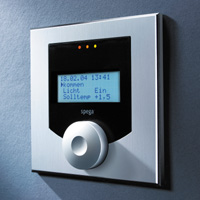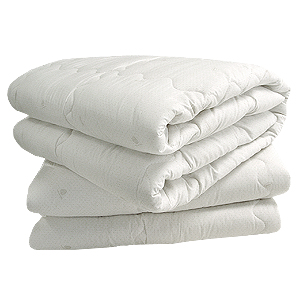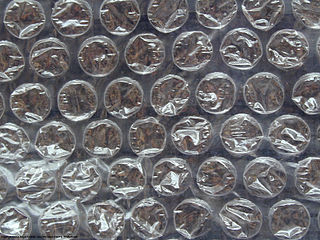Related Research Articles

Papermaking is the manufacture of paper and cardboard, which are used widely for printing, writing, and packaging, among many other purposes. Today almost all paper is made using industrial machinery, while handmade paper survives as a specialized craft and a medium for artistic expression.

Home automation or domotics is building automation for a home. A home automation system will monitor and/or control home attributes such as lighting, climate, entertainment systems, and appliances. It may also include home security such as access control and alarm systems.

A futon is a traditional Japanese style of bedding.
A waterbed, water mattress, or flotation mattress is a bed or mattress filled with water. Waterbeds intended for medical therapies appear in various reports through the 19th century. The modern version, invented in San Francisco and patented in 1971, became a popular consumer item in the United States through the 1980s with up to 20% of the market in 1986 and 22% in 1987. By 2013, they accounted for less than 5% of new bed sales.

A mattress is a large, usually rectangular pad for supporting a lying person. It is designed to be used as a bed, or on a bed frame as part of a bed. Mattresses may consist of a quilted or similarly fastened case, usually of heavy cloth, containing materials such as hair, straw, cotton, foam rubber, or a framework of metal springs. Mattresses may also be filled with air or water.

A duvet, usually called a comforter or (down-filled) quilt in American English, and a doona in Australian English, is a type of bedding consisting of a soft flat bag filled with either down, feathers, wool, cotton, silk, or a synthetic alternative, and is typically protected with a removable cover, analogous to a pillow and pillow case. The term duvet is mainly British, especially in reference to the bedding; rarely used in US English, it often refers to the cover. Sleepers often use a duvet without a top bed sheet, as the duvet cover can readily be removed and laundered as often as the bottom sheet.

Bedding, also called bedclothes or bed linen, is the materials laid above the mattress of a bed for hygiene, warmth, protection of the mattress, and decorative effect. Bedding is the removable and washable portion of a human sleeping environment. Multiple sets of bedding for each bed are often washed in rotation and/or changed seasonally to improve sleep comfort at varying room temperatures. Most standardized measurements for bedding are rectangular, but there are also some square-shaped sizes, which allows the user to put on bedding without having to consider its lengthwise orientation.

A bed is an item of furniture that is used as a place to sleep, rest, and relax.
A silk comforter (絲綿被) is a bed covering, most often used as a duvet, and also commonly referred to as a silk duvet, silk quilt, or silk blanket. Originally used and made in China, since the late 20th century, silk comforters have become more common in Western market areas. Their increasing popularity stems from a combination of factors, including their thermal properties, their light weight, and their natural hypoallergenic properties. The opening of the Chinese market to the world since the 1990s has also played a significant role in the spread of silk comforters, as China is both the world's biggest silk producer and silk comforter manufacturer.

A bed sheet is a rectangular piece of cloth used either singly or in a pair as bedding, which is larger in length and width than a mattress, and which is placed immediately above a mattress or bed, but below blankets and other bedding. A bottom sheet is laid above the mattress, and may be either a flat sheet or a fitted sheet. A top sheet, in the many countries where they are used, is a flat sheet, which is placed above a bottom sheet and below other bedding.

A comforter, also known as a doona in Australian English, or a continental quilt or duvet in British English, is a type of bedding made of two lengths of fabric or covering sewn together and filled with insulative materials for warmth, traditionally down or feathers, wool or cotton batting, silk, or polyester and other down alternative fibers. Like quilts, comforters are generally laid over a top bed sheet and used to cover the body during sleep. Duvets are another form of quilt, traditionally filled with feathers, though since the late 20th century often made of synthetic fibres or down alternatives.
Sonos, Inc. is an American audio equipment manufacturer headquartered in Santa Barbara, California, United States. The company was founded in 2002 by John MacFarlane, Craig Shelburne, Tom Cullen, and Trung Mai. Patrick Spence has been its CEO since 2017.

A timeline of United States inventions encompasses the ingenuity and innovative advancements of the United States within a historical context, dating from the Contemporary era to the present day, which have been achieved by inventors who are either native-born or naturalized citizens of the United States. Patent protection secures a person's right to his or her first-to-invent claim of the original invention in question, highlighted in Article I, Section 8, Clause 8 of the United States Constitution which gives the following enumerated power to the United States Congress:
To promote the Progress of Science and useful Arts, by securing for limited Times to Authors and Inventors the exclusive Right to their respective Writings and Discoveries.
The Internet of things (IoT) describes devices with sensors, processing ability, software and other technologies that connect and exchange data with other devices and systems over the Internet or other communications networks. The Internet of things encompasses electronics, communication, and computer science engineering. "Internet of things" has been considered a misnomer because devices do not need to be connected to the public internet; they only need to be connected to a network and be individually addressable.
Joy Mangano is an American inventor and entrepreneur known for inventions such as the self-wringing Miracle Mop. She was the president of Ingenious Designs, LLC, and appeared regularly on the U.S. television shopping channel HSN until her departure in late 2018. Mangano is the founder and CEO of Clean Boss, a company that develops and sells cleaning products.

A bed base, sometimes called a foundation, is the part of a bed that supports the mattress. The bed base can itself be held in place and framed by the bedstead. In the United States, box-spring bed bases are very common. In Europe, sprung slats are much more common.

Bubble wrap is a pliable transparent plastic material used for packing fragile items. Regularly spaced, protruding air-filled hemispheres (bubbles) provide cushioning for fragile items.

A duvet cover is a cover for duvet. The duvet cover protects duvet during use.

Bed-making is the act of arranging the bedsheets and other bedding on a bed, to prepare it for use. It is a household chore, but is also performed in establishments including hospitals, hotels, and military or educational residences. Bed-making is also a common childhood chore.

A tick mattress, bed tick or tick is a large bag made of strong, stiff, tightly-woven material (ticking). This is then filled to make a mattress, with material such as straw, chaff, horsehair, coarse wool or down feathers, and less commonly, leaves, grass, reeds, bracken, or seaweed. The whole stuffed mattress may also, more loosely, be called a tick. The tick mattress may then be sewn through to hold the filling in place, or the unsecured filling could be shaken and smoothed as the beds were aired each morning. A straw-filled bed tick is called a paillasse, palliasse, or pallet, and these terms may also be used for bed ticks with other fillings. A tick filled with flock is called a flockbed. A feather-filled tick is called a featherbed, and a down-filled one a downbed; these can also be used above the sleeper, as a duvet.
References
- ↑ Engeler, Eliane (2008). "World's biggest inventions fair features self-making bed". USA Today. Archived from the original on 2020-11-09. Retrieved 16 October 2017.
- ↑ Thurston, Anthony (1 December 2016). "The Self-Making Bed Has Arrived!". Digital Trends . Archived from the original on 1 December 2016. Retrieved 1 December 2016.
- ↑ Hughes, Matthew (30 November 2016). "SMARTDUVET is a self-making bed for the truly lazy piece of shit in your life". TNW . Archived from the original on 13 December 2016. Retrieved 18 June 2018.